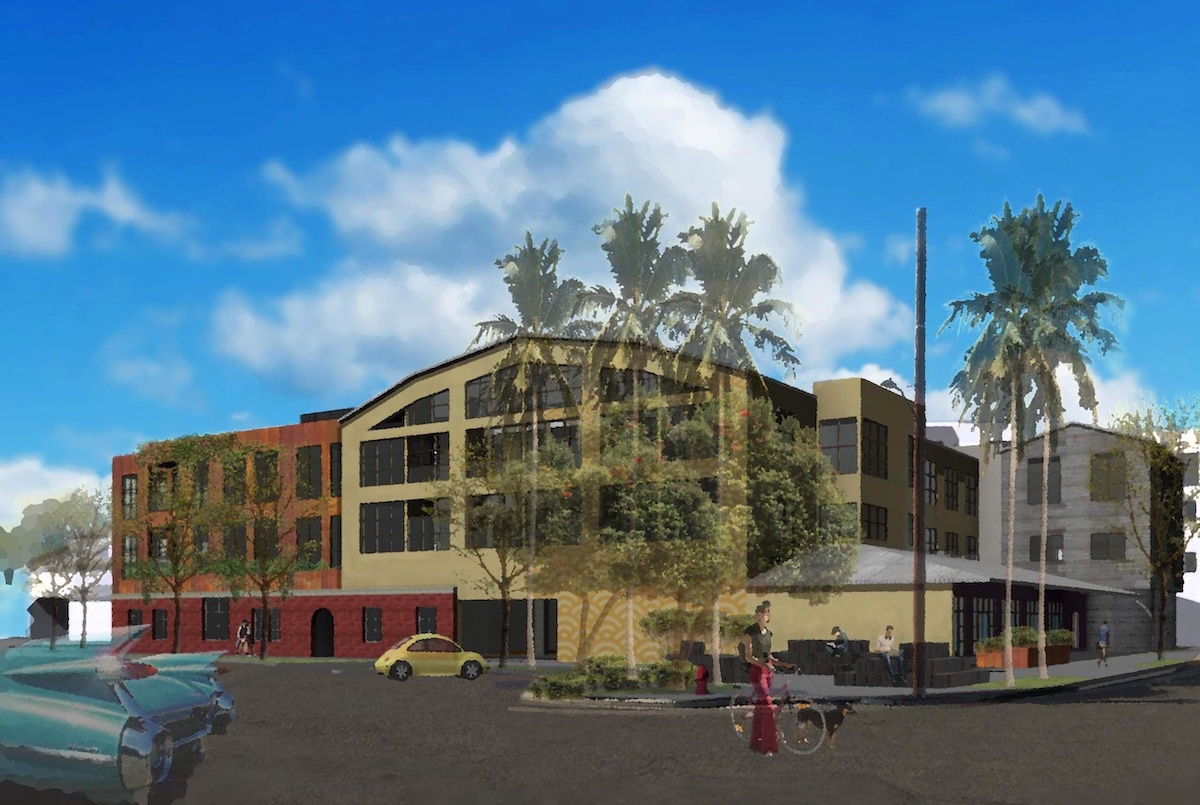The 155-residential-unit mixed-use “SOMOfunk” project began its long journey through the city review process Monday, as the Santa Barbara Architectural Board of Review (ABR) took a first crack at the design, which would create a whole new look for an entire city block in the Funk Zone.
The project’s principal architect, Christine Pierron, from Santa Barbara–based Cearnal Collective, presented the project’s latest redesign, which drew from the Funk Zone’s industrial and artistic roots with a collection of buildings that resembled an old-school California industrial district reimagined as a modern urban housing and commercial center. The design itself is a departure from what the Funk Zone has become known for — artist studios, surf shops, and small businesses — but the promise of a large swath of much-needed housing in a city scrambling to meet housing quotas makes the project especially attractive to city planners.
In the weeks leading up to this first public hearing, the development has drawn criticism from locals whose concerns range from the size and scale of the project to its impact on the city’s water usage to the affordability and availability of the units to city residents. During Monday’s meeting, at least 20 community members spoke in opposition to the project, and the board received 164 written letters from the public on the issue.
“As more and more of the community learns about this development, we’ll only see these numbers continue to grow,” said Brittany Zajic, a member of the nonprofit group Keep the Funk, Inc., which has already garnered hundreds of supporters. “It’s hard for the ABR to ignore such a response from the impacted community.“
Board chair Kevin Moore reiterated that the ABR’s purview was limited during this first concept review but that the board would be able to receive comments on the aesthetics of the design, materials, and landscaping.
Funk Zone residents, regulars, business owners, and employees held back no punches during the lengthy public comment, pleading to the boardmembers to consider the “authenticity” of the neighborhood, which has collected organically over the past decade and more. At one point, a community member produced a portable speaker, using her time to lead the packed David Gebhard public meeting room in a dance party to the tune of Parliament Funkadelic’s “We Want the Funk.”
Sign up for Indy Today to receive fresh news from Independent.com, in your inbox, every morning.
The board itself was generally supportive of the proposal and agreed 5-1 to move the project forward to the city’s Planning Commission, ruling that it “provisionally met” the criteria for the city’s design guidelines. Boardmember Steve Nuhn, who is also an architect at Cearnal Collective, recused himself out of conflict of interest; Dennis Whelan voted against the motion, saying the size was not appropriate for the area and that he “didn’t think it was compatible” with the surrounding neighborhood.
The board left plenty of comments for the Planning Commission to work with, suggesting that planners rearrange the proposed 18,000 square feet of commercial space to foster more traffic to the courtyard “paseos” and public spaces inside. The bulk of the project’s height, the board agreed, was packed into the middle of the design, and there was eventually an agreement that public views were not affected because, technically, the city only considers views for “specific gathering” spaces, and the Funk Zone did not have parks or spaces that would be affected.
As the design is tweaked and makes its way through the eight-step review process — from application to ABR concept review, city staff review, Planning Commission for recommendations, City Council for approval, back to ABR for a project and final design approval, and finally building permit approval — there will surely be lengthy discussion on each of the concerns brought up by community members. But with the city in the midst of a housing crisis, the question will be whether the city can afford not to build a project of this size. And if the public outcry is too great, the question becomes whether there exists a large-scale project that the city’s residents would stand behind, and if so, what would that project look like?
Neil Dipaola, the developer behind SOMOfunk, and the rest of the ownership team are convinced that this project is exactly what the city needs. The project’s 38 affordable units amount to more than any other privately funded developments over the last 24 years, they say, and it drew support from the notoriously critical Housing Authority. The developers say they also intend to enforce a “locals priority” criteria for the 142 apartments and 13 condominiums in attempt to keep out-of-town applicants from using the units as short-term rentals.
“It’s a very, very big project,” said boardmember Leon Olson. “However, to accomplish the housing that is desirable, size matters.”
Santa Barbara’s Planning Commission will take the next in-depth look at the project, though a date has not been set.
A three-minute virtual animation of the proposed design was shown at the Architectural Board of Review meeting on Monday, July 25 (from 2:33:00 to 2:35:40).
Support the Santa Barbara Independent through a long-term or a single contribution.




